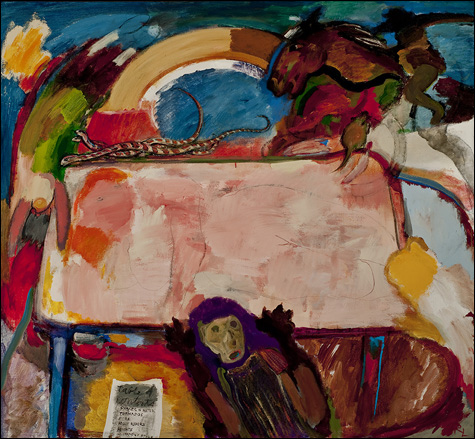
CENTERPIECE ‘Ground,’ by Richard Brown Lethem, oil, charcoal, and paint stick on linen, 64 by 78 inches. |
"One thing that's different about this show," Richard Brown Lethem tells me as we stand in the gallery where his paintings currently hang, "is that I'd never done a series before now. I've always tried to fit all the subject matter into one painting."
I can identify with this. I'm faced with the task of writing about the 78-year-old expressionist painter whose latest solo exhibit, "Table of Contents," just opened at Aucocisco Gallery. There's simply a ton of potential subject matter, and just like the stuff that makes up the sprawling, energetic canvases he's been painting for 60 years, it all threatens to come bursting into the frame.
"Table of Contents" is Lethem's first solo show in four years, and the latest in a career that began in one of the most influential art movements in modern history. I meet him for coffee, and upon learning that his paintings had been hung a bit earlier than originally planned, we decide to take a look. It's late in the day, and he and I are the only people in the gallery. I ask about a smaller series of his colorful oils, with thick brushstrokes of warm, heartland colors and a codified network of Xs, circles, and slashes of color at the center. They look like they could be distant hearkenings to crop circles, or perhaps, more true to form, a color study that defies representation.

THE SUM OF ALL FEARS ‘Table of Contents,’ by Richard Brown Lethem, acrylic, oil, and charcoal on cotton, 48 by 52 inches. |
"Oh, that's 'Pick and Roll,'" he explains. "It's a series I did recently about basketball. I really enjoy watching March Madness."
College sports wasn't the first subject I thought I'd encounter in this exhibit, but then again, Lethem's approach as a painter rejects no influence and leaves no stone unturned. In addition to basketball plans, this show explores monkey painters (in an ode to Chardin, and the artist's own Parisian stint), tabletops, carpentry, his mother, fear, and yes, nonrepresentational color fields.
It's possible to learn very much about Lethem's long, full life in intricate, sometimes surprisingly intimate detail (for starters, check the terrific, memoir-ish essay "Lives of the Bohemians: Growing Up With My Father's Paintings," written by his son, Jonathan), but the abridged version goes like this: Lethem was born to middle-class parents and raised in Missouri. His father was a traveling salesman, so Richard, the youngest of seven, grew up learning much from the stories and perspectives of his mother. One of these stories is the harrowing tale of a lynching that occurred not far from where the family lived, and although it happened before Richard was born, he still speaks of it as one of his life's most haunting recollections.